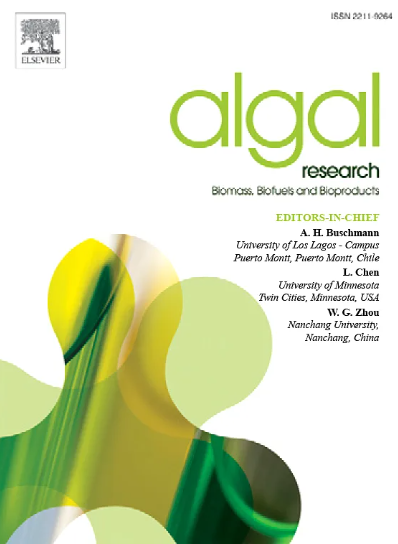南太平洋沿岸绿潮物种石莼的可持续生物炼制:抗氧化剂、寡糖和莼菜提取研究
IF 4.6
2区 生物学
Q1 BIOTECHNOLOGY & APPLIED MICROBIOLOGY
Algal Research-Biomass Biofuels and Bioproducts
Pub Date : 2024-11-02
DOI:10.1016/j.algal.2024.103785
引用次数: 0
摘要
本研究采用微波辅助萃取法,从绿潮汐物种石莼中回收有价值的生物化合物,确定了生物质的特征和可持续生物炼制。生物质的蛋白质含量为 21%;硫酸盐含量为 24.6%;脂类含量为 2.1%;碳水化合物含量为 27%;叶绿素 a 和叶绿素 b 的含量分别为 15%和 11%;类胡萝卜素含量为 4.6%。微波处理的温度对生物化合物的产量和质量都有影响,温度在 180 °C 至 220 °C 之间时,可溶性提取物中的酚类化合物浓度和抗氧化活性较高,温度在 120 °C 至 200 °C 之间时,低聚糖的浓度较高。在 120 ℃ 下进行微波处理可获得最高的溃疡素含量(21%),以及良好的分子量和粘弹性。此外,乌尔凡提取物在体外和体内毒理学实验中均未显示出毒性作用。这些发现凸显了绿潮汐作为各种生物化合物的可再生生物质来源的潜力,为未来的生物技术研究提供了可能性。本文章由计算机程序翻译,如有差异,请以英文原文为准。
Sustainable biorefinery of Ulva stenophylloides, a green-tide species from the South Pacific coast: A study on antioxidant, oligosaccharide, and ulvan extraction
In this study, biomass characterization and sustainable biorefinery were determined using microwave-assisted extraction to recover valuable biocompounds from the green-tide species Ulva stenophylloides. The biomass exhibits concentrations of 21 % for proteins; 24.6 % for sulfate; 2.1 % for lipids; 27 % for carbohydrates; 15 % and 11 % for chlorophylls a and b, respectively; and 4.6 % for carotenoids. The temperature of the microwave treatment influenced both the yield and quality of biocompounds, with higher concentrations of phenolic compounds and antioxidant activities observed in the soluble extracts at temperatures between 180 °C and 220 °C, and higher concentrations of oligosaccharides obtained at temperatures from 120 °C to 200 °C. Microwave treatment at 120 °C yielded the highest content of ulvans (21 %), as well as favorable molecular weight and viscoelastic properties. Furthermore, the ulvan extract demonstrated no toxic effect in both in vitro and in vivo toxicological assays. These findings highlight the potential of green tides as a renewable biomass source for various biocompounds, opening up possibilities for future biotechnology research.
求助全文
通过发布文献求助,成功后即可免费获取论文全文。
去求助
来源期刊

Algal Research-Biomass Biofuels and Bioproducts
BIOTECHNOLOGY & APPLIED MICROBIOLOGY-
CiteScore
9.40
自引率
7.80%
发文量
332
期刊介绍:
Algal Research is an international phycology journal covering all areas of emerging technologies in algae biology, biomass production, cultivation, harvesting, extraction, bioproducts, biorefinery, engineering, and econometrics. Algae is defined to include cyanobacteria, microalgae, and protists and symbionts of interest in biotechnology. The journal publishes original research and reviews for the following scope: algal biology, including but not exclusive to: phylogeny, biodiversity, molecular traits, metabolic regulation, and genetic engineering, algal cultivation, e.g. phototrophic systems, heterotrophic systems, and mixotrophic systems, algal harvesting and extraction systems, biotechnology to convert algal biomass and components into biofuels and bioproducts, e.g., nutraceuticals, pharmaceuticals, animal feed, plastics, etc. algal products and their economic assessment
 求助内容:
求助内容: 应助结果提醒方式:
应助结果提醒方式:


